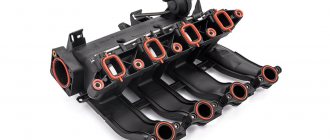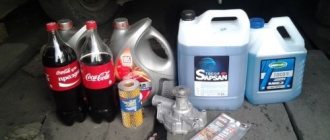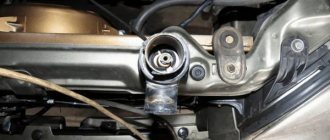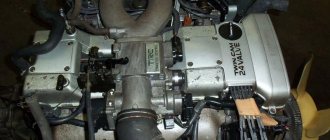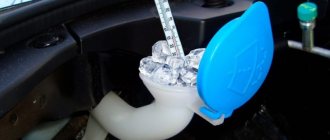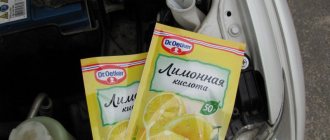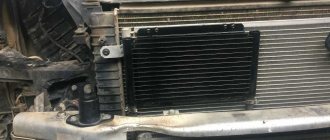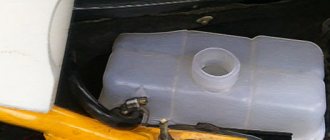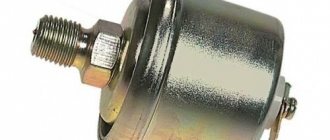During long-term operation of the vehicle, the engine cooling system may become clogged. The presence of dirt contributes to insufficient circulation of coolant in the system. As a result, the engine begins to overheat, and the efficiency of the stove decreases. To eliminate the occurrence of these malfunctions, the engine cooling system should be flushed.
The instructions for cleaning the engine cooling system on all modern LADA cars (XRAY, Vesta, Largus, Granta, Priora, Kalina, Niva 4x4) are similar. There are no fundamental differences.
The procedure for draining antifreeze on a Niva VAZ 2121
- The first step is to cool the engine if you have recently turned it off, that is, wait until it cools down to the outside temperature.
- Then unscrew the radiator filler neck.
- And disconnect the hose that goes to the engine block, thereby draining the antifreeze from the block:
- And we substitute some kind of container, you can make it from an old 10-liter plastic canister by cutting off its upper part.
- Next, you need to drain the antifreeze from the Niva’s radiator. To do this, use a 13mm head to unscrew the plug, which is located at the very bottom of the radiator on the left side. You can see everything clearly in the photo below:
- And again we substitute a container to drain the old coolant. After there is no antifreeze left in the cooling system, you can begin to pour fresh coolant through the expansion tank in a thin stream to avoid the formation of an air lock. We pour until the required level is reached - approximately in the middle of the expansion tank. And then we do the same procedure with the radiator until its upper tubes are hidden. Don't forget to first attach the hose to the outlet of the engine block.
- Antifreeze or other coolant should be poured through the expansion tank until the level in it reaches the maximum level.
For proper engine operation, a coolant is required, which must be changed over time. The article describes how to replace the Niva Chevrolet coolant and what you will need for this. In addition, there is a video that shows the process of filling and pumping coolant.
[Hide]
Radiator flushing technology.
Rust and dirt don't just form in the engine; your cooling system can fall victim to it too. Therefore, regular radiator flushing is a vital element that car owners often overlook. The engine cooling system protects the car from overheating caused by its operation and forces the engine itself to operate within temperature limits. Keeping your cooling system clear of rust and accumulated dirt will help your engine perform at its peak.
Replacement instructions
The procedure for replacing the coolant is not complicated, so even a novice car enthusiast can perform it.
How much to pour?
Antifreeze in a car, according to the manufacturer’s recommendations, should be changed after 40 thousand kilometers or after two years of operation. In this case, it is necessary to constantly monitor the condition of the coolant and check its level. If it has darkened or become cinnamon in color, then it needs to be changed. If the level is below the required level, add water or antifreeze. Replacement may be required if the coolant poured into the car does not meet the density.
The required volume of liquid to be filled is 10 liters. It is advisable to fill with coolant specified in the owner's manual.
Coolant
What will you need?
To carry out the replacement, you will need an inspection hole, a lift or an overpass. The machine must be installed horizontally and secured so that it cannot roll during work. The front of the machine should be installed higher than the rear. The procedure is carried out only on a cold engine. To carry it out you need to prepare the following tools and materials:
- spanner set to “10”;
- pliers;
- screwdriver;
- funnel;
- container for draining waste liquid;
- new antifreeze;
- clean rag.
A watering can can be made from a plastic bottle by cutting it in half. A canister or plastic water bottle is suitable as a container.
Stages
Having installed the car on the inspection hole, they begin to replace the coolant.
- First, open and secure the hood.
- The next step is to unscrew the cap on the expansion tank.
It is advisable to perform the procedure on a cold machine. Expansion tank Niva Chevrolet If this is not possible, then the coolant temperature should be no higher than 90 degrees. To avoid getting burned by steam or hot liquid, place a rag on the engine and around the neck of the expansion tank. The lid should be unscrewed carefully. First you need to unscrew it a little so that hot air comes out and release the tank from pressure, and then unscrew it completely. - Now unscrew the plug on the drain hole and drain all the liquid. When the used antifreeze has drained, screw the plug back into place.
- To prevent the formation of air plugs in the cooling system, you need to disconnect the hose from the throttle body fitting. To do this, use a screwdriver or pliers to loosen the fastening on the clamp and move it back. Then disconnect the hose from the throttle assembly fitting.
- Before adding coolant, it should be prepared. There are ready-to-use liquids, mainly antifreeze. There are antifreezes that require dilution with distilled water; usually the proportion is 50/50, unless otherwise indicated in the instructions.
- Next, you can proceed to filling the cooling system.
Coolant is poured into the expansion tank. As soon as it begins to flow out of the throttle body nozzle, put the hose on the nozzle and tighten the hose clamp. Next, continue to fill the antifreeze solution to the maximum mark in the expansion tank. - When pouring antifreeze solution, tighten the radiator hoses to prevent air pockets from forming.
- After the cooling system is filled, tighten the cap on the expansion tank.
- Next, you need to start the engine and wait for the electric fan to turn on.
If this does not happen, you need to check what kind of air is coming from the heater. If it is warm, then the fan is faulty; if it is cold, the reason is the presence of air pockets formed in the system. To get rid of them, you need to open the cap on the radiator, start the engine, and after 5 minutes of operation, turn off the engine. Now close the radiator cap. Removing the radiator cap - When the second cooling circle opens, the coolant level will drop significantly.
- You must wait until the engine cools down. Next, check the fluid level again. On a cold engine it should be between maximum and minimum, on a hot engine it should be at maximum. If necessary, add to the required volume.
The Niva SUV, in all modifications, is very popular in Russian spaces. This is due to good maintainability, low price and excellent maneuverability. To ensure reliable operation, you should undergo all maintenance on time, in particular, replace the coolant.
The liquid system with forced circulation of the VAZ 21214 car is designed for effective heat removal. It fully copes with its task, you just need to keep it in good condition.
Replacing antifreeze VAZ 21214
Replacing the coolant is a regulated maintenance procedure, which is prescribed in the operating instructions. There is nothing complicated about it if you clearly and carefully follow the described action plan.
Suitable for Niva cars:
- VAZ 21214
- VAZ 21213
- VAZ 2121
- VAZ 2131
Before you start replacing the coolant, to avoid getting burned, you need to wait until the engine has completely cooled down. You should also avoid getting antifreeze or antifreeze on the skin, eyes or digestive organs, since the chemical composition of the liquids is toxic.
Coolant drain
Before starting the draining procedure, you should prepare tools, containers for used antifreeze, as well as new liquids for subsequent refilling. If protection is installed under the engine, it can also be removed for convenience.
- turn the temperature regulator in the cabin to the maximum position to the right (Fig. 1);
- place a drain container under the radiator;
- we find the plug in the bottom left corner of the radiator and unscrew it (Fig. 2);
- We put a hose on the drain neck with an internal size of 16 mm and lower it into the drain container. This will prevent antifreeze from splashing;
- after that, unscrew the plug on the radiator filler neck to drain the liquid faster (Fig. 3);
- unscrew the fastening of the expansion tank and lift it up (Fig. 4). In this case, the liquid will drain through the radiator drain hole. And the tank itself can be completely removed and washed;
- To drain the coolant from the engine, you need to unscrew the drain bolt using a 13mm wrench. The bolt itself is located on the left side (Fig. 5).
After completing this operation, do not forget to put the expansion tank in place and also tighten all the drain plugs.
Flushing the cooling system
If there are deposits in the drained liquid or there is a transition from antifreeze to antifreeze, the system should be flushed. To do this you need to do the following:
- Flush the system with plain water through the expansion tank of the VAZ 21214. The plugs must be open;
- tighten the drain plug and bolt;
- fill the system with a flushing agent (you can use Liqui Moly Kuhlerreiniger or Lavr cooling system flush) with distilled water (6-7 liters);
- start the engine. Warm up to 90 degrees;
- leave it idling for 5-10 minutes, depending on the contamination of the system;
- muffle it. Allow the engine to cool to approximately 60 degrees;
- drain the flush using the same steps as removing the old fluid;
- tighten both plugs;
- fill with distilled water to rinse the cooling system;
- start the car and warm up to 90 degrees;
- turn off and let cool to 60 degrees, drain;
- repeat steps 8, 9, 10 and 11 if necessary.
Filling antifreeze into Niva 21214, 21213 without air locks
To fill new fluid into the cooling system, you can use the instructions described in the book on car repair and operation. But when doing this, motorists very often end up with air jams.
Air locks can cause the engine to overheat and boil. And also the heating stove in VAZ 21214, VAZ 21213 (Niva) may not work.
So, let's start filling it correctly:
- before filling, unscrew the hoses supplying antifreeze to the throttle valve heating unit and lift them slightly up (Fig. 1);
- remove the plug from the filler neck of the radiator and begin to fill in antifreeze until it is completely filled (Fig. 2);
- after this, we begin to expel air from the upper radiator pipe (Fig. 3). By pressing and pulling it with your hand towards the filler neck. When performing this procedure, air bubbles should appear in the neck;
- we twist something like a funnel out of a plastic bottle and insert it into one of the pipes (Fig. 4);
- We begin filling through the funnel until the liquid reaches the upper edge of the radiator filler neck. Screw the lid on it tightly;
- After this, we continue filling through the funnel until antifreeze flows from the second pipe. We put both pipes in place and tighten the clamps (Fig. 5);
- pour antifreeze into the expansion tank a few centimeters above the MIN mark;
- We start the car, warm it up to operating temperature, let it run for 5 minutes, then turn it off.
The filling of the liquid is completed, all that remains is to wipe off the spilled antifreeze and wait for the engine to cool. With the car now cooled down, check the level in the expansion tank again and top up if necessary.
Stages of replacing Chevrolet Niva coolant
When switching from antifreeze to antifreeze, it is necessary to flush the cooling system. This is done so that the new liquid does not lose its properties when mixed. Also, due to the different chemical composition, a precipitate or flakes may form. Therefore, the correct procedure between draining and filling should include a flushing step.
This model is quite popular, so many people know it under other names:
We will consider the instructions for replacing the coolant using the example of a 1.7-liter gasoline engine. But there is one nuance: cars after the 2020 restyling have electronic control of the gas pedal.
Accordingly, there are no pipes for heating the throttle valve. Therefore, we will consider bleeding air on this modification. You can also familiarize yourself with the nuances of replacement on a regular Niva 4x4, the replacement on which we also described.
Coolant drain
To drain the antifreeze, you need to place the car on a flat surface, open the cap of the expansion tank and wait a little until the temperature drops below 60°C. For further convenience, remove the decorative plastic protection on top of the engine.
Further in the instructions we are recommended to turn the temperature regulator to maximum. But it is useless to do this. Since the temperature control in the Chevrolet Niva occurs by moving the air damper. And not by blocking the radiator as in old VAZs.
After the machine has cooled down a little, we begin the draining process itself:
- If you stand in front of the car, at the bottom right, there is a plastic valve on the radiator that closes the drain hole. We unscrew it to drain the antifreeze from the radiator (Fig. 1). When unscrewing, be careful not to lose the rubber O-ring.
In this way, we completely drained the old fluid, but in any case, a small part still remains in the system, distributed among the engine channels. Therefore, in order for the replacement to be high-quality, we proceed to flushing the system.
Flushing the cooling system
If the Chevrolet Niva cooling system is not clogged, but is simply undergoing a scheduled replacement, then we use ordinary distilled water for flushing. To do this, close the drain holes and pour distilled water into the expansion tank.
Then close the tank cap and start the engine. We warm it up until the thermostat opens to flush both circuits. Next, turn it off, wait for it to cool and drain the water. To achieve a good result, it is recommended to do this procedure 2-3 times.
If the car system is heavily contaminated, it is recommended to wash it with special chemical solutions. For these purposes, washes from well-known brands, such as LAVR or Hi Gear, are suitable. Recommendations, as well as instructions, are usually printed on the back of the container with the composition.
Filling without air pockets
To properly fill new antifreeze into a Chevrolet Niva, you need to perform a number of steps. After all, it depends on whether an air lock forms in the system or not. We will close the drain holes in stages, so for now we will leave them open:
- We begin to pour antifreeze into the expansion tank, as soon as it flows through the drain hole in the radiator, we put the wing plug in place.
- We continue the flood until it starts flowing from the hole in the block. After which we close it too. The drain bolt on the block must be clamped with a slight force, approximately 25-30 N•m, if you have a torque wrench.
- Now we need to bleed the air from the top of the radiator. To do this, we find a special plug, the location of which is shown in the photo (Fig. 3). We unscrew it a little, continue to pour antifreeze into the tank, as soon as it flows, screw the cap back into place.
The system is completely filled with new antifreeze, now all that remains is to start the engine, wait until it warms up completely, and check the level. Some people advise starting the car with the reservoir open and closing it after 5 minutes to get rid of air pockets as much as possible. But when replacing according to these instructions, they should not be there.
Replacement frequency, how much and what kind of fluid is needed
According to the manufacturer's recommendation, it is necessary to replace antifreeze or antifreeze on VAZ-21214 cars every 3 years or after a mileage of 60 thousand kilometers. If the car is used in more severe conditions, then it is advisable to replace it more often - every 30-40 thousand kilometers.
- loss of coolant properties. You can check the quality of the antifreeze used using a test strip, which is sold in the same places where the liquid itself is sold. Place the strip in the expansion tank, then pull it out. The strip comes with a color scale, according to which you can understand how much longer the car can be used before replacing the coolant;
- change in color of the coolant to tan or red. This means that rust has appeared in it;
- the appearance of sediments, flakes and dense formations in the liquid.
In all cases, it is necessary not only to replace, but also to check the entire engine cooling system for serviceability.
The coolant for the VAZ 21214 Niva injector should have a freezing point no higher than -40 degrees. Typically, the manufacturer fills in TOSOL TS-40 (manufacturer in Dzerzhinsk). When replacing antifreeze, it can be replaced with antifreeze with G12 approval; it is safer for the entire cooling system. You can also use original Lada G12 antifreeze, which is suitable for all cars of this manufacturer.
Antifreeze volume table
How often does antifreeze need to be changed in Daewoo Nexia?
When operating a Daewoo Nexia car, antifreeze should be periodically added to the tank without replacement or cleaning procedures, since these models have a powerful engine that requires constant cooling. Over time, the level drops and to avoid major and costly breakdowns, you need to check it once a month.
However, the operating instructions provide information that every three years or every 45 thousand kilometers the antifreeze on the Daewoo Nexia must be replaced.
These deadlines were not calculated by car developers and manufacturers by chance. The optimal mileage and time are calculated under ideal driving and environmental conditions that affect the antifreeze and cooling system. Even in the best conditions, replacement is required after 45,000 km.
To properly replace antifreeze in this car in Russia, it is important to remember about environmental pollution, aggressive driving and bad roads in the country. Thus, the optimal solution would be to change the antifreeze every year.
How to change coolant on Daewoo Nexia
A Daewoo car needs coolant to do several parts of the job at once. The most basic multifunctional component is cooling in the injector operating system. Replacing the cylinder head gasket of a VAZ 2114 8 valves with your own. How much does it cost to replace standard valves on a VAZ 2110 8 valves. With normal indicators and timely replacement of the refrigerant, the temperature sensor
will show 90-100 C. Therefore, if your characteristics are higher, then the antifreeze should be replaced with Daewoo Nexia.
Functions that coolant does:
- Maintains normal temperature conditions during injector operation (temperature sensor indicators).
- Maintains low temperature conditions
during gearbox operation. (temperature sensor indicators). - Heating the car interior in winter. Antifreeze provides heat in the cabin due to the fact that the engine heats the liquid and the fan circulates it.
Replacing antifreeze in a Daewoo Nexia car should happen every 40 thousand km or once every 2 years, depending on how often you drive the car. Replacing the timing belt on an 8-valve, replacing antifreeze on a Daewoo Nexia, Nexia. This must be done because the quality of the poured substance is constantly deteriorating and susceptible to corrosion.
Radiator on a Daewoo Nexia car
Replacing the heater valve VAZ 21214 Niva without draining antifreeze
Niva cars sometimes have problems associated with the failure of some parts of the cooling system, such as a thermostat or pump. If they break down, they are replaced as an assembly, fortunately they are not expensive. Also a common problem are leaking hoses or a cracked expansion tank, which also needs to be replaced.
But there is another problem with the VAZ 21214, a leaking heater valve. Because of this, there may be a smell of antifreeze in the cabin, wet floor mats on the front passenger side, or the heater may not work.
There are several ways to replace a faulty faucet:
- complete draining of antifreeze from the system;
- clamp the stove pipes with special clamps;
- Place your Niva on a slope, with the hood down.
But there is another option that is more clear and simple. To do this, you need to disconnect the pipes going to the stove under the hood, point them upward and fix them in this position. The next step is to remove the stove itself:
- unscrew the console;
- disconnect the latches securing the stove;
- there is no need to disconnect the buttons;
- move the radiator assembly, along with the tap and pipes, towards the driver;
- we take out the entire structure through the space between the steering wheel and pedals;
- That's it, you can change the tap itself.
After replacement, reassemble in reverse order. As you can see, this operation is quite simple, and antifreeze will not leak into the cabin. And the procedure takes only 40 minutes, even for an unprepared person.
Consequences of untimely replacement
Briefly about the consequences of untimely replacement of refrigerant:
- Deposits will form in the cooling system. Loss of refrigerant properties will lead to the appearance of sediment, which will primarily clog the expansion tank and radiator unit. Because of this, antifreeze will not be able to circulate effectively through the cooling system lines.
- The heater will not work efficiently. The performance of the stove will be impaired as a result of obstruction of the pipes due to the formation of deposits in them. This problem usually occurs during the cold season.
- The car engine will overheat. If replacement intervals are violated, the life of the refrigerant will expire, causing it to lose its properties. Because of this, antifreeze will not be able to effectively cool the engine, which will ultimately cause overheating. Constantly driving a Daewoo Nexia with an overheated engine will lead to the destruction of the inter-ring partitions on the internal combustion engine pistons. Because of this, the plane on the blocks where the cylinder head is installed will be curved. Also, constant overheating will lead to rapid failure of the seals. They will begin to ooze and leak grease, so you will have to look for the oil leak.
Video
Replacement of antifreeze on Niva 21214 cars, according to the manufacturer’s recommendation, should be done every 3 years, or after 60,000 mileage. When operating in difficult conditions, it is advisable to carry out work more often - every 30-40 thousand kilometers.
What antifreeze and how much should I fill in Niva-21214?
When choosing coolant for Niva 21214, you should rely on the manufacturer’s recommendations. Based on application practice, the following types of antifreeze can be used:
- For cars produced in 2009, red coolant G12+ is suitable. The optimal options are Zerex G, VAG, Frostschutzmittel A, and FEBI.
- For Niva 21214 cars produced after 2010, it is worth using red G12++ class antifreeze. The most popular manufacturers here are Castrol Radicool Si, MOTUL, Freecor QR, Freecor QR, FEBI and others.
Other coolants also performed well - Sintek, Cool Stream (Premium and Standard), as well as TC Felix Antifreeze.
Antifreeze should be replaced not only during the periods indicated above, but also if a reddish tint appears. This indicates a deterioration in the composition of the coolant or the presence of a counterfeit in the cooling system.
The optimal volume of antifreeze required to refill the system is 10.7 liters.
Replacement process
Work is carried out only on a cooled engine and on a level area (pit, overpass). If a horizontal section cannot be found, a slight lifting of the front of the car is allowed.
Before draining the antifreeze, remove the negative terminal from the battery, and also remove the protection from the motor (if installed). Afterwards, prepare the necessary tools. To replace antifreeze on a Niva 21214 car, you will need “fifteen” keys, a “thirteen” socket with a knob and an extension, as well as a ratchet handle (it will be more convenient with it). Also buy new antifreeze to fill the system, find a container larger than 11 liters, as well as a dry rag.
- Head into the salon and open the heater tap.
- In the engine compartment, find the expansion tank and unscrew the plug from it.
- Unscrew the radiator cap. At the initial stage, this may not be done. If you leave the cap in place, the coolant will come out with less activity, which eliminates splashing.
- Place a container with a volume of 11 liters or more under the approximate location for draining. At the same stage, prepare a tube having an internal diameter of 1.6 cm.
Antifreeze drain
Let's look at how to drain antifreeze from a radiator. To do this, remove the cover, which is located on the left, at the bottom of the device, connect the prepared tube to it and wait until the coolant leaves the system. The presence of a tube is necessary to avoid splashing of dangerous liquid.
Proceed to the next step - drain the old antifreeze from the cylinder block (hereinafter - BC) of the Niva-21214 engine. To do this, do the following:
- take a key set to “thirteen” (preferably with a socket and an extension), then unscrew the plug installed on the lower left side of the engine BC;
- drain the coolant from the system using the same hose as for the radiator.
Drain the antifreeze from the expansion tank. For this:
- remove its fastening, open the plug and raise the container above the level of the radiator filler outlet; these actions are enough for the remaining antifreeze to come out of the tank;
- Now tighten the drain plugs, place and secure the expansion tank in its original place.
When replacing antifreeze, please note that the connection for the BC plug uses a conical thread. Its peculiarity is that there is no need for compaction. The plug on the Niva-21214 cylinder block is pulled with a force of 25-30 N*m using a torque wrench.
Filling with new antifreeze
Go through the final stage of replacing antifreeze - fill in the prepared coolant. For this:
- Pour antifreeze into the radiator hole. Make sure that the upper coolant level reaches the top edge of the filler hole.
- Pour coolant into the expansion tank. The level should be 30 mm above the MIN sign.
- Start the engine and let it warm up. The cap on the radiator must be closed. Pay attention to the hose leading to the radiator from the engine. It will be cold for a while, but after a few minutes it will warm up. This confirms the fact that the liquid went in a large circle.
- Wait until the fan starts and turn off the engine.
Wait for the coolant to cool, check the level again and top up (if required). At this point, the replacement of antifreeze is completed. If necessary, expel air pockets from the system, for which, let the engine run with the radiator cap removed (the front of the car should be higher than the rear).
Now you know how to drain the antifreeze in a Niva 21214 car, and then fill the system with new coolant. This information is enough to do all the work yourself and not contact specialists.
Video: How to replace the coolant and remove the air lock on a Niva
If the video does not show, refresh the page or
To refuel and service a domestic VAZ SUV, you need to know the filling capacities of the VAZ 21213 Niva and its modifications, the VAZ 21214. Some numbers need to be known by heart, for example, the capacity of the tank and engine crankcase. The rest should be written down in a notepad, which is stored in the glove compartment of the cabin. And it doesn’t matter that you are not going to do the maintenance of the car yourself, the specialists at the service station may also not know the refueling volumes of your car.
Preparing for work
Before draining antifreeze from the Daewoo Nexia block, you should determine the volume of liquid. The coolant level can be determined by eye by diagnosing the amount of antifreeze in the tank. Open the hood and look into the reservoir in which the antifreeze is stored. The tank is marked with MIN and MAX marks. If the liquid level is between these marks, then the volume of refrigerant is optimal. You should not check the amount of fluid while the car is running with a hot engine, as the coolant level will be higher.
Power unit
The engine installed on the modern model of the Niva 21213 (214) car was inherited from its Soviet progenitor - the VAZ 2121, and in terms of fluid volumes they are almost identical:
- Liquid cooling system. Filled with antifreeze in an amount of 10.7 liters with a freezing point not higher than -40 ° C. The capacity of the interior heating radiator is also included in this volume.
- Crankcase. Motor oils are poured here, the brand of which depends on the operating conditions. Capacity: 3.75 liters, including oil filter filling.
The viscosity of the oil poured into the Niva engine must correspond to the outdoor temperature at which the car is operated. Possible modes and suitable oil brands are shown in the table:
When flushing the power unit during the process of replacing liquid lubricant, the same amount of flushing oil (3.75 l) is used, taking into account the size of the filter. Replacement is carried out after 8-12 thousand kilometers, depending on the quality of the oil. Flushing is usually performed after 3 engine lubricant changes. During operation, it is important to monitor the oil level in the engine crankcase using a special dipstick. If the level drops below the Min mark, it is urgent to add lubricant to the engine of the same viscosity as was previously filled.
Antifreeze needs to be updated at least once every 3 years or according to the degree of wear of the fluid. It is not recommended to dilute antifreeze with distilled water, either in winter or summer. In winter, the diluted liquid may freeze, and during the summer heat it may boil ahead of time, which will lead to overheating of the engine.
Leaks and problems
When replacing the coolant, you should inspect all pipes and connections for possible problems. After all, when the fluid is drained, it is easier to replace them than to tear them during operation. You need to pay special attention to the clamps; for some reason, many people use ordinary worm clamps. Over time, they squeeze the hoses, causing them to break.
In general, the Chevrolet Niva has several main problems related to the cooling system. It often happens that antifreeze leaves the expansion tank. The plastic on it constantly bursts, which causes leaks. In this case, replacement will be required.
Another problem is antifreeze under the driver's mat, which can cause a sweetish smell in the cabin and also fog up the windows. Most likely the culprit will be a leaking heater radiator. This problem is usually referred to as “a chef’s nightmare.”
There is also a situation where antifreeze is thrown out of the expansion tank. This may indicate a broken cylinder head gasket. This is checked as follows. With the car completely cooled down, remove the expansion tank cap, after which you need to start the engine and rev it up intensively. It is advisable to have a second person so that he can see whether the antifreeze in the tank will bubble at this time.
It is necessary to fill the Chevrolet Niva with antifreeze, strictly observing the established frequency. It is assigned by the manufacturer and amounts to one fill per 40 thousand kilometers. In exceptional cases, if the driver uses the vehicle little, antifreeze can be added once every couple of years.
It should be borne in mind that the volume of antifreeze should be regularly checked and urgently changed if a brownish tint or dark color of the liquid is detected. In addition, replacement of technical fluid is necessary if it does not meet the established density values or the engine requires major overhaul.
Transmission
The Niva 4x4 transmission system has the following filling volumes:
- transfer case - 0.79 l;
- gearbox - 1.6 l;
- rear axle - gearbox - 1.3 l;
- front axle - crankcase - 1.15 l;
- steering column - crankcase - 0.18-0.2 l.
As with the operation of a power unit, under different temperature conditions, transmission units and assemblies are filled with oils of different viscosities, which is reflected in the table:
As stated in the operating instructions, transmission lubricants need to be changed once every 30 thousand km. mileage At the same time, replacement is not provided for in the steering mechanism housing, only an addition through the top plug. The “native” oil for Zhiguli transmission units is considered to be TAD17I.
Transmission oils have good penetrating ability. Therefore, poorly clamped plugs and worn gaskets of units begin to gradually leak lubricant. In such situations, it is allowed to add oil of the same viscosity class and, preferably, the same manufacturer. If you do not top up during a leak, the lubricant level in the unit will decrease, which will lead to accelerated wear of expensive mechanisms.

